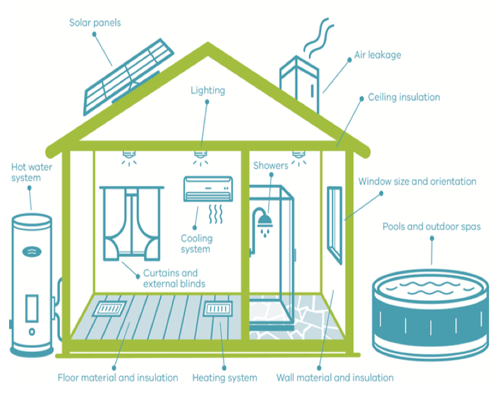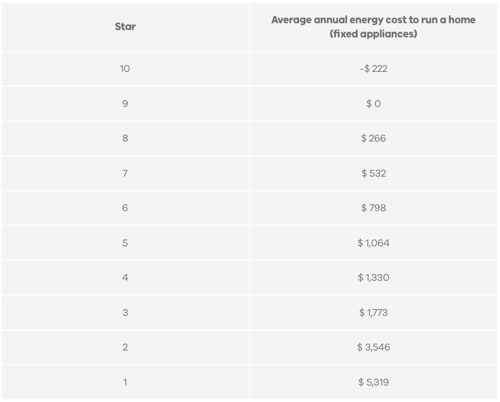6 min read
Passive House Retrofit
What is a Passive House Retrofit?
Passive House retrofit is the process of upgrading an existing building to meet the...

The National Residential Efficiency Program builds upon the Victorian Government's state-based Residential Efficiency Scorecard Program to provide a consistent approach to assessing the efficiency of existing homes. The voluntary assessment allows Australian homeowners to understand their energy performance and therefore identify ways to improve.
Certified Energy are the leaders in sustainability services. Our accredited scorecard assessors will give you the best recommendations on increasing the energy efficiency of your home.
The creation and ideation of the Residential Efficiency Scorecard is based on the Victorian state-based Residential Efficiency Scorecard, and is a national initiative to provide Australians with a simple star rating system which evaluates and determines the energy efficiency of their home. As a national home energy rating system used across Australia, it is hoped the initiative will provide all Australians with recommendations for their homes and give insight into future energy concerns ensuring efficiencies and cost reductions. The program is currently endorsed by NatHERS and is also currently being phased into NatHERS with expected completion during 2022.
See what a Scorecard Report actually looks like
The energy star rating, or Scorecard rating provides an easy way of understanding how a home compares in its energy cost compared to the rest of Australia.
The Scorecard energy star rating is similar to how white good appliances such as washing machines are energy star rated. The Residential Efficiency Scorecard Rating shows how much energy is used throughout the home.
The average home energy star rating is 3 stars.

There are a number of factors involved in the evaluation of the Residential Efficiency Scorecard asessment. Below is a simple representation of what areas and systems will be assessed.

During the on-site assessment, one of our accredited assessors will collect information data on room sizes, window type, placement, constructional material, insulation and furnishings. With these in consideration, our assessor will also check your hot water system, heating, cooling, lighting and any other significant energy users in the house.
This is a basic breakdown of the savings a household could achieve if they followed the recommended guidelines set in the Residential Efficiency Scorecard.
A general rule of thumb is that the lower your energy star rating is - the more practical improvements can be implemented into your home to save on energy costs and create a more energy efficient home.

Financial institutions across Australia have continued to allow financial incentives for mortgages which are more energy efficient.
The future of using your Residential Efficiency Scorecard Assessment to improve your mortgage application is a reality. This is because of the simply energy star rating system which easily identifies what your true energy costs are for your home.
You could even improve your chances to be eligible for home financing packages from participating financial institutions. By gaining a higher Residential Efficiency Scorecard rating for your home you have an increased chance of accessing these incentives.
Contact your existing financial institutions to find out if you're eligible or get in touch with us for further advice.
1. Fill Out a Form to Check Your Eligibility
2. Approval for Eligibility
3. Plan Ideal Time and Day for On-site Assessment
4. On-Site Visit from Accredited Assessor
5. Allow 1-2 hours for On-site Assessment
7. Receive Residential Efficiency Scorecard
Our accredited assessors have strong industry knowledge and many years in the field. We follow all government guidelines and requirements in order to deliver the best in service.

In a time of rising energy costs and increased climate awareness, the Scorecard serves as a critical resource for homeowners who are committed to reducing their energy consumption and carbon footprint. By offering a clear and comprehensive assessment of a home’s energy performance, the Scorecard empowers homeowners to make informed decisions about upgrades and renovations that will deliver the greatest return on investment.
The Residential Efficiency Scorecard offers numerous benefits for homeowners. One of the primary advantages is the identification of cost-saving opportunities. By highlighting areas where energy efficiency can be improved, the Scorecard helps homeowners reduce their energy bills and achieve long-term savings.
Another significant benefit is the enhancement of year-round comfort. Homes that are more energy-efficient are better at maintaining consistent indoor temperatures, leading to increased comfort during both summer and winter months. Additionally, energy-efficient homes tend to have better air quality and less reliance on heating and cooling systems, contributing to a healthier living environment.
What is a Passive House Retrofit?
Passive House retrofit is the process of upgrading an existing building to meet the...
Prior to commencing most types of developments in NSW, you will have to lodge a Development Application (DA) with your...
Building for the Australian Climate.
A building’s access to sunlight is one of the leading factors contributing to its...
FOR IMMEDIATE RELEASE
Sydney, 11 March 2025
Certified Energy is pleased to announce our...